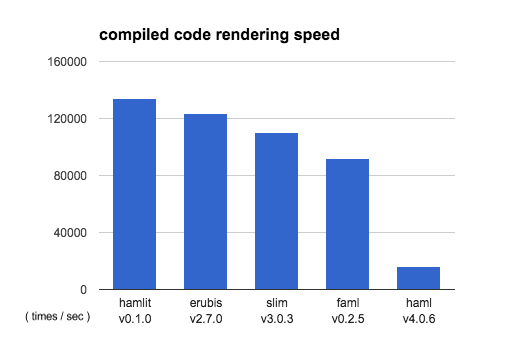Hamlit is a high performance haml implementation.
Add this line to your application's Gemfile:
gem 'hamlit'or just replace gem "haml" with gem "hamlit".
Hamlit's rendering is 8.47x times faster than original haml.
hamlit: 133922.9 i/s
erubis: 123464.1 i/s - 1.08x slower
slim: 110404.3 i/s - 1.21x slower
faml: 92009.3 i/s - 1.46x slower
haml: 15810.4 i/s - 8.47x slower
This benchmark is the same as slim-template/slim's one for fairness. (The result on travis CI)
Haml's attribute parser is not so good. For example, raises syntax error for %a{ b: '}' }.
Hamlit's attribute parser is implemented with Ripper, which is an official lexer for Ruby,
so it is able to parse such an attribute.
haml/haml-spec is a basic suite of tests for Haml interpreters. For all test cases in haml-spec, Hamlit behaves the same as Haml (ugly mode only, which is used on production).
Hamlit is used on githubranking.com.
Basically the same as haml. Check out the reference documentation for details.
Haml's rendering is very slow because generated code by haml runs many operations on runtime. For example, Haml::Util is extended on view, attribute rendering runs even if it is a static value and the values in attribute is sorted. All of them is achieved on runtime.
Hamlit extends ActionView beforehand, attribute rendering is done when compiled if it is a static hash and no unnecessary operation is done on runtime.
Hamlit is implemented with temple, which is a template engine framework for Ruby. Temple has some great optimizers for generated code. Thus generated code by Hamlit is very fast.
Not only relying on temple optimizers, but also Hamlit's compiler cares about many cases to optimize performance such as string interpolation.
MIT License
